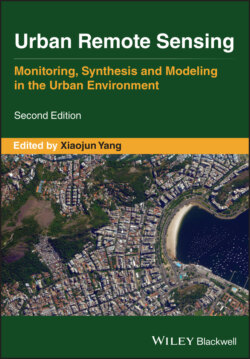Читать книгу Urban Remote Sensing - Группа авторов - Страница 57
3.3.3 DATA PROCESSING (POSTFLIGHT)
ОглавлениеOnce all image data have been collected and organized from a UAS, they can be processed into other geospatial products depending on the sensor type and flight plans used. For a RGB sensor, individuals can utilize the images collected to generate a multitude of photogrammetric outputs, such as orthophotos (Strecha et al., 2012; Hardy et al., 2017), DEMs (Kršák et al., 2016; Agüera‐Vega et al., 2017), and 3D point clouds (Siebert and Teizer, 2014; Trhan et al., 2016). The methods to generate these products from UAS imagery have improved significantly over the last decade with the introduction of photogrammetric software for use with UAS data (Colomina and Molina, 2014; Yao et al., 2019). Built on the concepts of Structure from Motion (SfM) and multi‐view stereo (MVS) photogrammetry, these software packages can process UAS data to derive 2D/3D geospatial outputs. Examples of these software packages include Pix4DMapper (www.pix4d.com), DroneDeploy (www.dronedeploy.com), Agisoft Metashape (www.agisoft.com), ESRI Drone2Map (www.esri.com/en‐us/arcgis/products/drone2map), and 3DF Zephyr (www.3dflow.net/3df‐zephyr‐pro‐3d‐models‐from‐photos/). In addition to the commercial software packages, there are open‐source options providing similar photogrammetric capabilities, such as OpenDroneMap (www.opendronemap.org) and MICMAC (www.micmac.ensg.eu), although they are not as user‐friendly compared to the commercial software packages. Since most of these packages have become viable for generating robust geospatial outputs with UAS images in recent years, there is a lack of a firm understanding of the impact of the specific software’s algorithms on model outputs (Lavecchia et al., 2017). In addition, there has been a notable lack of cross‐comparisons of output quality generated among different photogrammetric software packages. There has been some efforts targeting this issue by comparing specific packages (Alidoost and Arefi, 2017; Barbasiewicz et al., 2018; Gagliolo et al., 2018; Brach et al., 2019; Forsmoo et al., 2019), but there is still a need to continue investigating the performance of these different software platforms.
Although there is a variety of UAS‐oriented photogrammetric software packages available, they can generate several common outputs, such as 3D point clouds, orthophoto maps, DEMs (surface and/or terrain), and 3D textured models. Fortunately, photogrammetric software packages utilize relatively common conceptual workflows, although their specific terms/steps may vary. By utilizing SfM and MVS algorithms, photogrammetric software packages can automatically extract 3D features from the UAS images by finding common feature points between overlapping images (Lowe, 2004). According to Remondino et al. (2011), a typical UAS photogrammetry workflow includes the following: mission planning, ground control measurements (if needed), image acquisition, camera calibration, image orientation, and image processing to generate 3D data.
